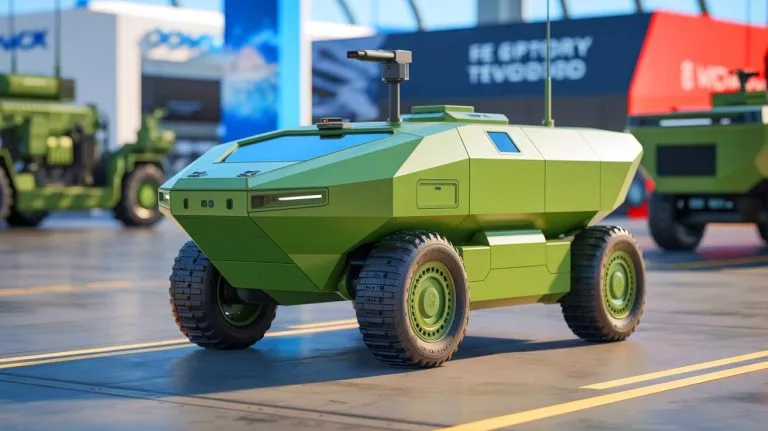| IN A NUTSHELL |
|
At the forefront of military innovation, European companies are increasingly turning to sustainable energy solutions to power their advanced technologies. Recently, a groundbreaking hydrogen-powered unmanned ground vehicle (UGV) named Hermione was unveiled at the International Defence Industry Exhibition (MSPO) in Kielce, Poland. Developed collaboratively by Polish defense firm P.H.U. Lechmar and French company H2X-Defense, Hermione represents a significant step toward integrating clean energy into military operations. With its modular design, rapid refueling capabilities, and extensive operational endurance, Hermione promises to reshape the landscape of battlefield support vehicles.
Unveiling Hermione: A New Era in Military Technology
The International Defence Industry Exhibition (MSPO) in Kielce served as the stage for the introduction of Hermione, a hydrogen-powered UGV designed to meet the modern military’s demand for cleaner, more efficient technologies. The collaborative effort between P.H.U. Lechmar and H2X-Defense aims to provide a versatile platform capable of supporting various battlefield tasks while significantly reducing emissions. This innovation aligns with the global push for sustainable energy solutions in defense applications.
Hermione’s unveiling as a technology demonstrator highlights its potential to adapt to diverse roles on the battlefield. During the MSPO exhibition, the vehicle demonstrated its capability as a UAV carrier, showcasing its ability to handle a payload of 661 pounds. Future iterations of the UGV promise to support payloads of up to two tons, making it a formidable asset in logistics and combat scenarios. With its advanced sensor packages and remote-controlled weapon stations, Hermione is set to redefine the flexibility and adaptability required in modern military operations.
Built for Flexibility and Endurance
Hermione’s modular design is central to its operational versatility, allowing it to fulfill multiple roles on the battlefield. Whether tasked with carrying drones, providing logistical support, or conducting reconnaissance missions, Hermione’s adaptability is unmatched. The UGV’s all-wheel drive and top speed of 24 mph ensure that it can navigate challenging environments with ease, making it an ideal choice for diverse military applications.
In terms of dimensions, Hermione measures approximately 11 feet in length, 6 feet in width, and 4.6 feet in height. Its ground clearance of nearly 12 inches enables it to traverse rough terrains effectively. Despite its robust capabilities, the UGV maintains a relatively lightweight profile, weighing around 1,543 pounds in its current configuration. This balance of power, flexibility, and endurance positions Hermione as a game-changer in the realm of unmanned military vehicles.
Hydrogen Power at Its Core
The heart of Hermione’s innovation lies in its hydrogen propulsion system. This cutting-edge technology utilizes TPED-certified cylinders to store hydrogen, which powers eight hub-mounted electric motors. Each motor delivers 8 kW of power, ensuring the vehicle’s operational efficiency. Complementing the hydrogen system is a 25 kWh battery pack, which allows Hermione to maintain a mission duration of up to 20 hours.
The refueling process for Hermione is notably efficient, taking just three minutes to fill its hydrogen tanks. Alternatively, the vehicle’s hydrogen cylinder can be swapped in the field, minimizing downtime and maximizing operational readiness. This rapid refueling capability is a crucial advantage for military operations that demand quick turnaround times and sustained endurance. The collaboration between Lechmar and H2X-Defense underscores the growing interest in low-emission, high-endurance platforms for frontline operations.
Expanding the Hydrogen Ecosystem
Alongside Hermione, H2X-Defense showcased the G-15/050 field generator, another hydrogen-based system designed to support mobile operations. Available in configurations ranging from 20 to 40 kW, this generator provides essential power for unmanned platforms like Hermione. The integration of hydrogen systems into military applications highlights a broader trend within the defense industry towards sustainable energy solutions.
The emergence of hydrogen-based technologies represents a pivotal shift in military strategy. By offering long endurance, rapid refueling, and modular designs, these platforms could become the backbone of future frontline operations.
The collaboration between European defense companies exemplifies the potential of hydrogen energy to transform both civilian and military sectors. As the demand for efficient, low-emission technologies continues to rise, Hermione stands as a testament to what can be achieved through international cooperation and innovation.
As Hermione enters the spotlight, it raises important questions about the future of military technology and the role of sustainable energy in defense strategies. How will the integration of hydrogen power impact the landscape of military operations, and what further innovations might we expect as other countries explore similar technologies? As the defense industry continues to evolve, these questions remain at the forefront of discussions on the future of military innovation.
Did you like it? 4.5/5 (22)








Wow, refueling in 3 minutes? That’s faster than my morning coffee! ☕️
Wow, refueling in 3 minutes? That’s faster than my morning coffee! ☕️
Interesting concept, but I wonder about the cost implications for taxpayers.
Would it be possible for these UGVs to be used in civilian applications too?
How does the 25 kWh battery pack contribute to its overall endurance?
Three minutes to refuel? That’s incredible. How did they achieve such efficiency?
Is Hermione going to require a lot of maintenance given its advanced technology?
What are the safety measures in place for handling hydrogen in combat zones?
Great innovation! This could really change the way we think about military logistics.
Will the refueling infrastructure be a challenge for deploying these UGVs in remote areas?
Can it be hacked? Cybersecurity is a big concern with autonomous tech. 🔒
Is there any info on the cost per unit? Wondering how budget-friendly this is. 💵
Not sure I’d want a 2-ton payload rolling around without a human driver. 😬
Hermione seems like a game-changer. How soon can we expect these in the field?
What about the environmental impact of producing hydrogen fuel?
These innovations make me hopeful for the future of clean military tech.
How do these robots perform in extreme weather conditions?
This is amazing, but are there any alternatives to hydrogen being considered?
Could these robots potentially perform rescue operations in disaster zones?
How does the modular design enhance its operational capabilities?
The top speed is 24 mph. Is that fast enough for combat scenarios?
Refueling in 3 minutes sounds great, but how long does it take to produce the hydrogen?
Will there be any public demonstrations of Hermione’s capabilities? 📢
I’m all for zero emissions, but what about the noise level? Stealth is key in combat.
Can Hermione be deployed via air drops? Just thinking logistics here. ✈️
How does it compare to other UGVs currently in use by the military?
What is the expected lifespan of these UGVs in active service?
Great article! These advancements in military technology are incredible. Thank you for sharing!
Any plans to collaborate with other countries on this technology?
I’d love to see this tech applied to humanitarian missions too. 🤝
How does this innovation fit into the broader strategy of European defense forces?
Awesome stuff! Are there any videos showing Hermione in action?
Why not solar power? Seems like an obvious choice for a sustainable energy source. ☀️
Can Hermione climb steep inclines? Just curious about its terrain capabilities. 🏔️
Finally, some eco-friendly military tech! Thanks for sharing this. 🌿
How reliable is the hydrogen propulsion system in extreme combat conditions?
Why the name “Hermione”? Is there a Harry Potter fan in the development team? 😂
I’m curious, how does Hermione compare to similar UGVs in terms of cost and maintenance?
Does anyone else think this sounds like something out of a sci-fi movie? 🤖
Zero emissions are great, but how reliable is the hydrogen technology under combat conditions?
The name Hermione seems more magical than military, don’t you think? 😂
Are there any other companies working on similar tech outside of Europe?